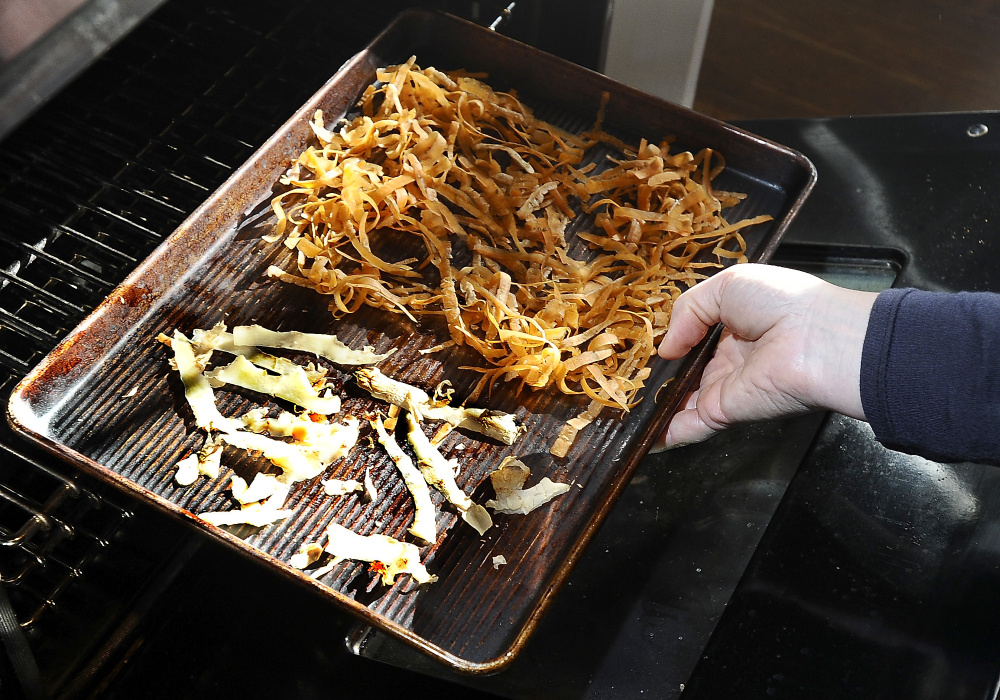When December rolls around, my inner Martha tends to show off.
There was the year I crafted a hundred Christmas cards from cute pictures of the kids, a rubber stamp, gross-grained ribbon and grommets. Another year I unrolled the kids’ easel paper across the kitchen floor, let them strip down to their skivvies and slop around in water-based paint to create gift wrap covered with red, blue and green chubby hand and little feet prints.
To this day, my husband resents the year I gave away his single-malt Oban Scotch in the form of homemade mustard because I thought I’d grabbed the sherry decanter in which to soak the mustard seeds.
If my social media feed is any indication of what’s trendy, flavored salts are way more fashionable this year than whisky-laced mustard. Yes, I am fully aware that complicated SEO algorithms decide what’s trendy these days, but just the same, Good Housekeeping, Saveur Magazine and Boston-based “Food Gift Love” author Maggie Battista all tell me how easy it is to make and give flavored salts that help elevate the taste of everything from a simple salads to sassy desserts.
Infusing a salt with any flavor simply means that you take a dry, flavorful herb, spice, peel or seed; do something (toast, grind, zest) to release its flavor; mix it with salt and put it in a pretty jar with a label, a bow and a few suggestions for its use.
Since I’ve got easy access to Maine sea salt, I decided to give it a go, but with an unusual green spin. My flavorings would be trash (every bit as trendy as flavored salts these days, incidentally). Think of it as Martha Stewart meets Dan Barber, the New York City chef who creates high-end meals like veggie burgers made with pulp left over from juice bars and meatloaf made from an old dairy cow and potatoes deemed unfit for grocery sales.
I was peeling local carrots, beets, celery root and ginger to make a roasted vegetable dish and mulling over what flavors I’d like in a finishing salt to top it off. Since I was roasting them to concentrate their flavor, it hit me: I wanted more carrot, beet, celery root and ginger flavor! The answer to my own query lay in the washed peelings sitting on the cutting board.
So as the vegetables roasted on a sheet pan on the top shelf of a 375 degree F oven, I toasted the peels in separate little piles on a second sheet pan on the bottom shelf, just to the point where they curled but did not burn. I cooled them and ground them again, separately, in my spice grinder, taking care to wipe out the top of the grinder to capture all of the flavor dust possible.
Then I played mix and match until I arrived at flavors that pleased me: carrot-ginger; earthy beet and espresso; and double celery (celeriac peel plus celery seed) salt. The ratio for most flavored salts is one heaping tablespoon of flavorings to 1 cup of salt. It’s best to let them sit overnight before using to let the flavors get to know each other.
In her book, Battista volunteers great advice on which type of salt works best for which flavors. She says to consider whether you’re making a salt to cook with, bake with or finish a dish with. If you envision the salt being sprinkled on sizzling steak or a rich chocolate truffle, go with a flaky sea salt. If it’s intended to season a roasting chicken or top off glazed carrots (see recipe), a coarse salt is best. If you’ve got baking in mind, use a fine sea salt.
I think Martha and Dan make a fine team, don’t you?
Glazed Ginger Carrots with Carrot-Ginger Finishing Salt
Glazed carrots remind me of Sunday dinners growing up. I’ve swapped Mom’s brown sugar and butter for local, spicy ginger brew and added the finishing salt. If you double this batch and drop half into 2 cups of vegetable stock and simmer for 10 minutes before pureeing, you’ve got soup for Monday’s lunch in the bag.
Serves 4
1 pound carrots, peeled and cut on the bias 1/4-inch thick
2 tablespoons unsalted butter
1 cup Maine Root Ginger Brew (or any spicy ginger ale)
Minced carrot tops (if you can find them this time of year)
1/2 teaspoon Carrot-Ginger Finishing Salt
Combine the carrots, butter and ginger brew in a large skillet over medium heat. Cover and bring to a simmer. Reduce the heat to low, give the pan a good shake and simmer 5 minutes more.
Remove the lid and turn up the heat to high. Cook, stirring occasionally, until the liquid has reduced to a glaze, about 5 minutes more.
Sprinkle with minced carrot tops and finishing salt.
Christine Burns Rudalevige is a food writer, recipe developer and tester, and cooking teacher in Brunswick. She writes about feeding her family Maine seafood at familyfish.net. Contact her at cburns1227@gmail.com.
Send questions/comments to the editors.



Comments are no longer available on this story